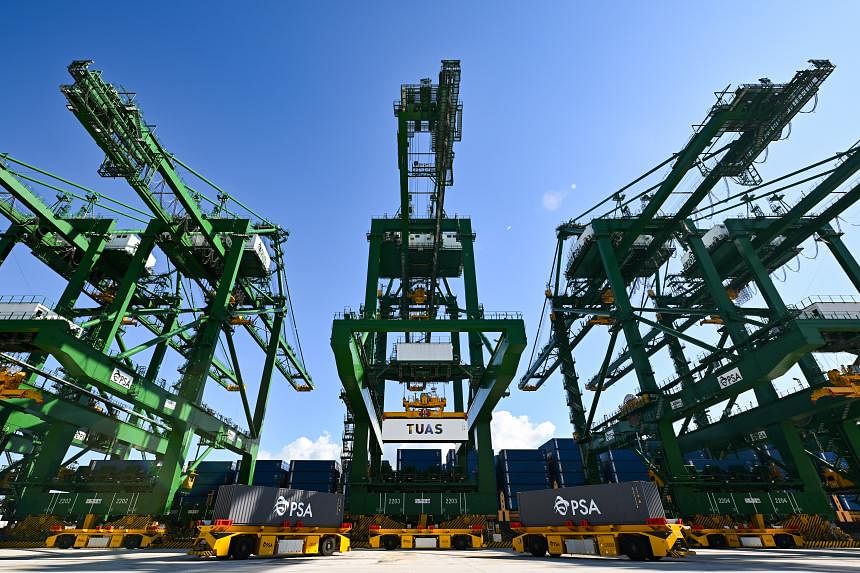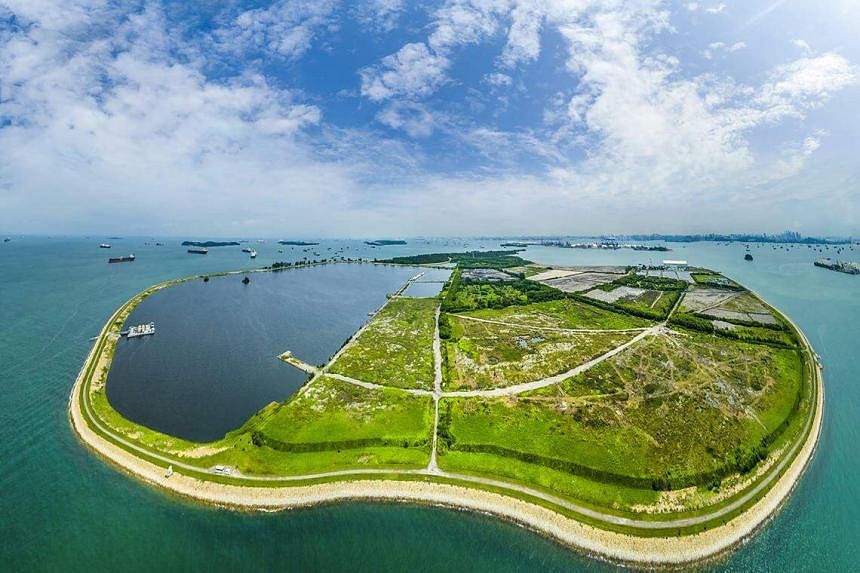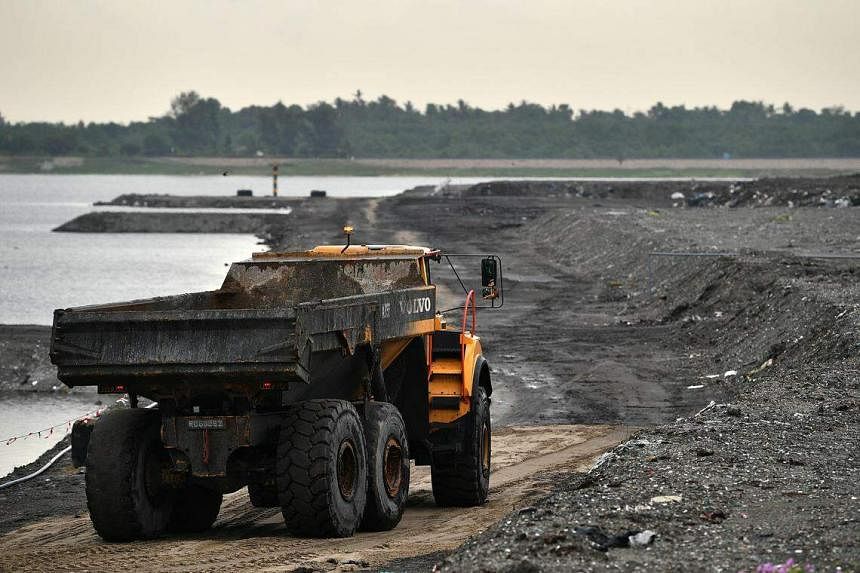
SINGAPORE – About one-tenth of the materials needed to reclaim land for Phase 3 of Tuas Port could come from Semakau Landfill, freeing up a large portion of the country’s only landfill.
Within the next five years or so, the National Environment Agency (NEA) aims to mine the landfill waste, possibly mix it with cement and use it as an alternative to sand for the reclamation, The Straits Times has learnt.
The plan is to excavate about 10 million cubic m of landfilled waste, which is about 35 per cent of the 28 million cubic m that Semakau can hold. Tuas Port Phase 3 – which is being planned – will need more than 100 million cubic m of reclamation fill.
In response to queries from ST, NEA said it is working with the Maritime and Port Authority of Singapore to study the use of mixed materials from Semakau Landfill for reclamation. “Mixed materials” refers to materials such as incineration bottom ash and wastewater sludge that are dumped together into the landfill.
“If mixed materials could be used as reclamation fill, the requirement for conventional fill material such as sand can be reduced, and space at Semakau Landfill freed up,” said NEA.
At current waste disposal rates, Semakau is expected to be filled up by 2035.
NEA is looking for a multidisciplinary consultancy to design the mega-project and possibly provide supervision services throughout the entire mining period, which is expected to be between 2027 and 2029.
A civil and environmental engineering professor who studied the waste in the landfill had previously said waste that is more similar in quality to fresh incineration ash can be easily washed, chemically treated or gasified.
But buried waste that has been exposed to the elements for up to 20 years can be trickier to work with. This is because the older materials might be either cleaner than fresh waste or more contaminated with hazardous materials.

Alternatives to sand have already been used for construction in Singapore. Newsand – a construction material made from incineration bottom ash – was used to make concrete benches and a footpath in Our Tampines Hub.
Municipal waste and waste soils have also been used in reclamation overseas, such as for Japan’s Port of Osaka.
On Dec 7, NEA put up a request for information on government procurement site GeBiz, inviting consultancies with expertise in civil and structural engineering, mechanical and electrical engineering and quantity surveying to submit proposals by Jan 5. Five submissions will be shortlisted for the tender stage.
More than half of the landfill – which is divided into two sections – is now full. Nearly all of the first phase (13.6 million cubic m) and about 10 per cent of the second phase (14.5 million cubic m) are filled up with the nation’s waste.
The waste is likely to be excavated from Phase 2 of the landfill – which resembles a lagoon – and three landfill plots next to it which are part of Phase 1.
NEA’s project brief said tenderers can assume that the amount of cement to be mixed with the mined waste should be 5 per cent to 10 per cent of the waste’s weight, and the final product should be discharged at Tuas Port Phase 3 within 12 hours. The tentative plan is for the appointed consultant to be given the cement-mixing recipe in the second or third quarter of 2024.
The document stated that NEA has identified the use of cement to render the excavated waste “environmentally inert”.
The agency said adding cement to make landfill waste environmentally safe for use as reclamation fill is still being studied, with the help of testing, environmental modelling and assessments.
Mr David Ng, honorary secretary of the Institution of Engineers, Singapore, said the chemical content in cement could be mixed with water in the excavated materials to bind the mass together.
“As a result, the mixed materials will be prevented from reacting with other materials. Thus, it could be stabilised in this manner,” he added. The materials could then act like the aggregate in normal concrete.
NEA added that the consultant will develop detailed plans for excavating the buried waste, treating and stockpiling it, and mixing it with cement at Semakau before it is transported to Tuas Port Phase 3. The consultant will also design new infrastructure, including a cement mixing plant.

This planning stage is likely to happen between 2024 and 2025. Excavation and reclamation are expected to happen between 2027 and 2029, with the first 12 months focused on building up stockpiles of the mined ash and other waste. In the remaining two years, the waste will be mixed with cement and continuously shipped to Tuas Port Phase 3.
The mining and stockpiling process could be autonomous or operated remotely, and NEA intends to study the possibilities with the consultant’s help.
Preparing for and minimising environmental impacts caused by the entire project is also a major expectation of the appointed consultant. For example, the consultant should develop a plan to address the accidental spillage of mined waste into the sea and ensure the impacts can be quickly fixed, the project brief stated.
The landfill is completely closed off to the sea to prevent leakage, and excavation activities must not compromise that.
Mr Ng noted that the potential release of toxic gases and leakage to the environment during excavation must be studied.
Pulau Semakau has been called the “Garbage of Eden” in a nod to the biodiversity on the island, from mangroves to seagrass meadows and coral reefs. The island is also part of Singapore’s Southern Islands, which are teeming with sea life and home to the country’s remaining healthy reefs.
There should be pollution containment measures to ensure that the processed and stockpiled waste does not cause contamination, dust and odour issues on Semakau. The appointed consultant shall also conduct engagement sessions with relevant groups such as government agencies, environmental groups and experts to address their concerns, if any.
Dr Jani Tanzil, facility director at the St John’s Island National Marine Laboratory, is hoping that the project will involve studies looking into the effects of the waste-based reclamation material on local marine creatures and ecosystems.
Noting that the potential project is a good idea, she said: “It helps us solve our burgeoning landfill space issue and, at the same time, (the) reclamation material challenge. I hope that locally relevant ecotoxicology studies will be done and results shared. We need to make sure our built and natural environment remains healthy for both humans and marine life.”
When Tuas Port – comprising four phases – is completed in the 2040s, it will be the world’s largest fully automated port. The port was officially opened in 2022, and land reclamation works for Phase 2 are in progress.
https://www.straitstimes.com/singap...ed-to-reclaim-land-for-mega-tuas-port-project
